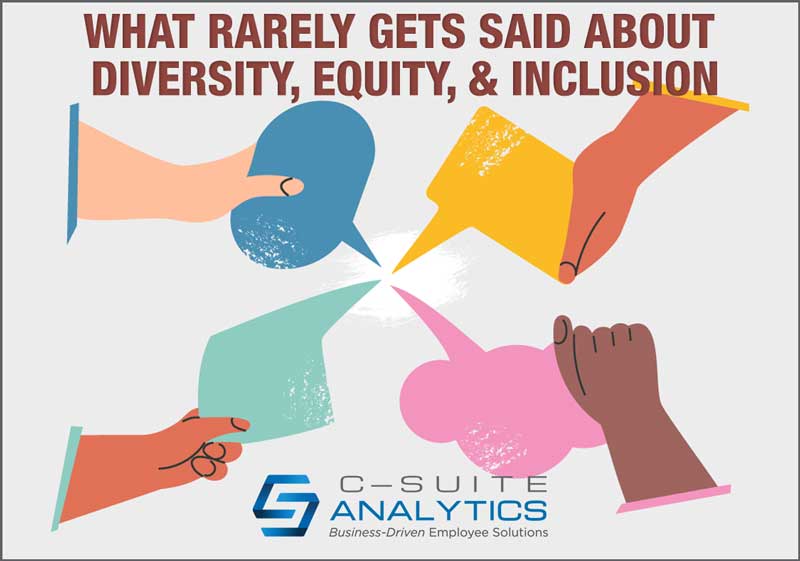AI, deportations, tariffs, and birthrate declines are reshaping America's workforce—blue- and white-collar alike. From baby boomer exits to AI disruptions, breaking down the workforce challenges no leader can afford to ignore.
What Rarely Gets Said About Diversity, Equity, & Inclusion

Diversity, Equity, & Inclusion Has Evolved
If one were to write a history of diversity, equity and inclusion (DEI), included would be the 1964 Civil Rights Act, affirmative action and EEO, George Floyd’s murder, the Black Lives Matter movement, and the resulting acronym DEI. The not-so-subtle spotlight would be on race, yet DEI implementation has evolved to also include the diverse thoughts of our employees rather than just their skin tone, language, gender, sexual preferences, or heritage.
I just returned from a summer vacation in Scandinavia, purposely to explore my very deep interest in happiness by witnessing the components of daily joy in Norway, Sweden, and Denmark. Trust me, we in the USA have far more opportunities to capitalize on DEI than Scandinavians do.
Start with what Diversity, Equity, & Inclusion Usually Includes
But there is a missing chunk in the way US companies are approaching DEI, and it’s a very, very important chunk. Let’s start first with what is usually included.
The Association for Talent Development, formerly ASTD, has been the authority for workplace training since 1943. Incredible. Yet reading their site page on DEI tells us they keep quite current as evidenced by these suggested DEI training topics. I’ve shortened some definitions without changing their meaning:
- Self-reflection: Help employees engage in self-reflection to learn their own power, privilege, and access, along with where they lack such things.
- Historical context: Historical roots of bias, discrimination and connections to current social movements.
- Legal context: Major legislation and judicial decisions connected to DEI.
- Workplace scenarios: Case studies, role plays, or scenarios showing how overt or subtle bias impacts employees in the workplace.
- Role-specific training: How learners can take steps to combat bias and create more diverse, equitable, and inclusive workplaces.[i]
Then there is a plethora of DEI programs spread among our leading corporations such as…
- DEI directors and departments
- Employee resource groups
- Affinity groups
- DEI-focused town hall meetings
- Diversity councils
- Inclusion broadcast series
- “Employee listening” surveys and focus groups
- Confidential employee grievance policies
- DEI promotion goals and standards
- Teaching “uncomfortable conversations”
And more programs to connect outside of organizations like developing relationships with historically Hispanic and Black colleges, requiring diverse vendors, and focusing on diverse customers.
Diversity, Equity, & Inclusion Missing Approach
What’s the major missing chunk? Supervisor-employee relationships. If I told you that 70% of employee engagement hinges on those relationships, that employees’ opinions of their bosses drive their opinions of their pay, benefits, development, and advancement…and that the #1 reason employees stay or leave or engage or disengage is how much they trust their boss, then we would all agree that overlooking this absolutely most important component in new-found DEI approaches is wrong. And each statement in this paragraph is fact.
Diversity, Equity, & Inclusion Intersection with Retention
But this major DEI miss is a continuation of most organizations’ failures to solve retention and engagement as well. There are two very opposite ways to reduce turnover and improve engagement with one being implementing one-size-fits-all programs…the ineffective way…and the correct but rare approach of driving retention and engagement directly through first-line supervisors.
So how do we build the intersection between DEI and supervisor/employee relationships? Ten years ago I invented Stay Interviews based on coaching I received from an organizational psychology professor, that supervisor trust was the genesis of everything good in organizations. That when employees hopped into their cars at the end of the day to de-compress, their thoughts were about bosses, colleagues, and duties as opposed to pay, benefits, and other one-size-fits-all programs. That when asked over dinner about their day, not one employee’s mind raced toward pet insurance or other programs. They were focused on people instead, and the primary “people” was their boss.
Diversity, Equity, & Inclusion is a Huge Benefit for American Companies
Everything about DEI is terrific for American companies, their workplaces, and their employees. And all feelings of equity and inclusion begin with the supervisor/employee relationship. The five Stay Interview questions are the pivot point for leaders to learn how each individual employee wants to learn and relate with their manager, while also providing a gateway each employee’s drivers for retention and engagement. The resulting initiatives then build that one-on-one relationship into a trusting relationship, and one where inclinations regarding diversity, equity, and inclusion flow naturally.
I like to say that Stay Interviews are all good. That not only are they the foundation for retention, engagement, and now DEI, but that they also push back that any of these essential workplace outcomes can be achieved with one-size-fits-all programs alone. And Stay Interviews are also the very best way to expand DEI initiatives from race and other demographics to gaining the diversity of thoughts.
Use Stay Interviews to Improve Employee Retention, Even During The Great Resignation
Schedule a conversation with me at DFinnegan@C-SuiteAnalytics.com to discuss your employee retention roadblocks and I’ll share ideas for how you can move forward and what is working for other companies to cut turnover by 20% and more, even during The Great Resignation that may benefit you.
[i] https://www.td.org/talent-development-glossary-terms/what-is-dei-training?gclid=CjwKCAjwrZOXBhACEiwA0EoRD0yG-T2_1XzONNe177D61hJMeCTKO55Qb7lbD7aCCH1yFtqKhLrO7hoClRUQAvD_BwE



